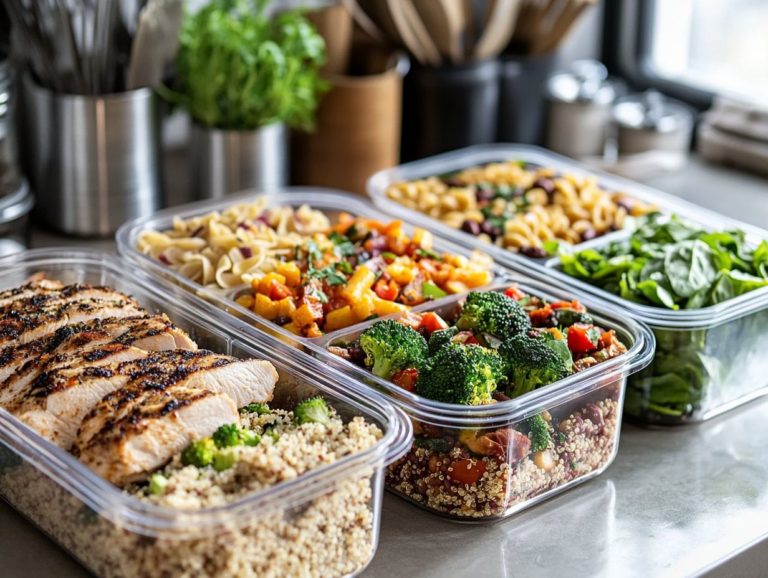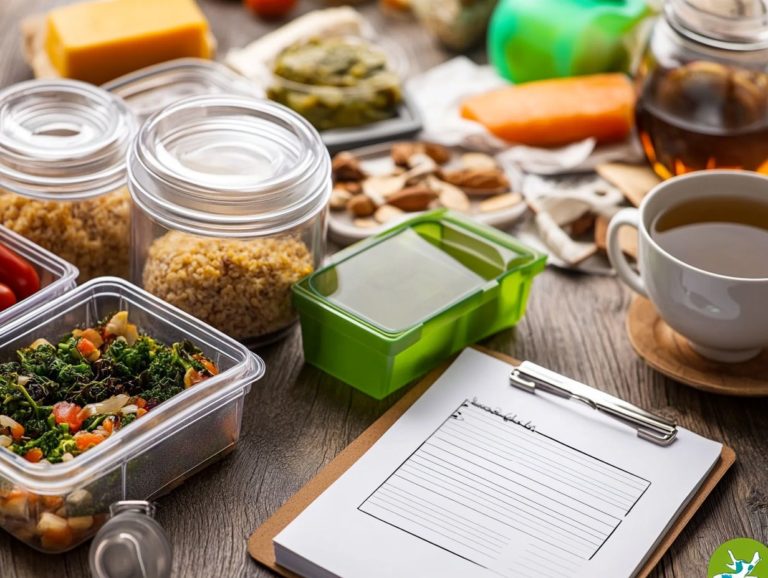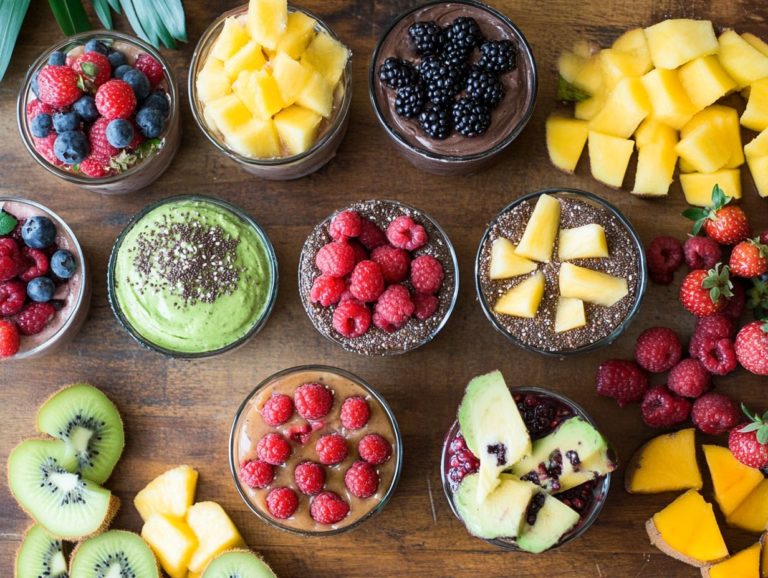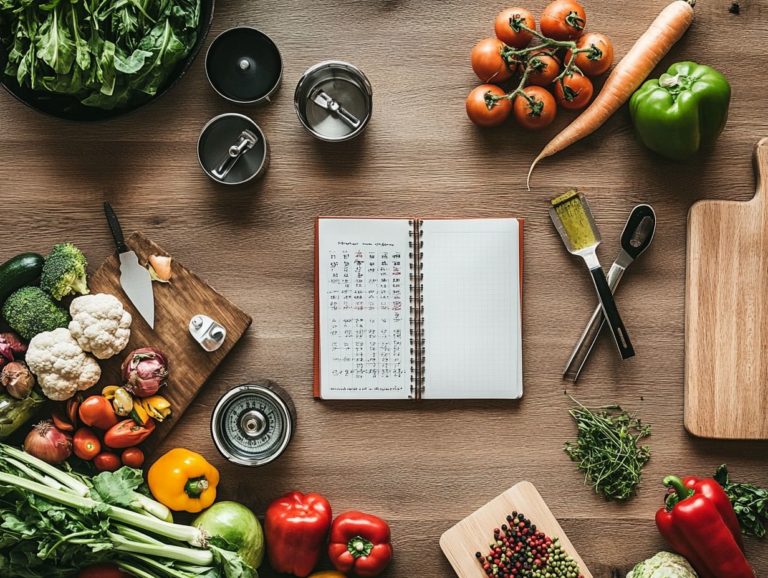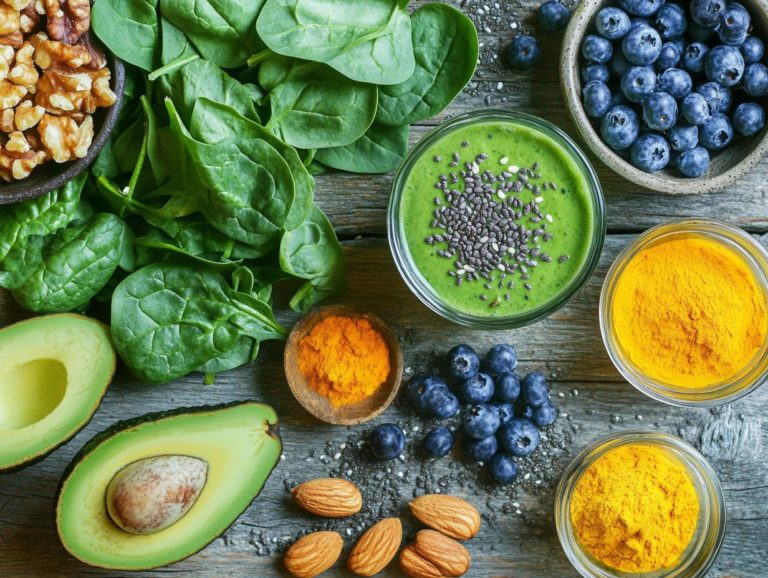How to Plan Meals for a Gluten-Free Diet
Navigating a gluten-free lifestyle may appear daunting at first, but it opens the door to a realm of delectable possibilities and remarkable health benefits.
This article delves into what gluten is and why many individuals opt to avoid it. You will uncover the advantages of a gluten-free diet, ranging from enhanced well-being to more effective meal planning strategies.
It also guides you on how to read food labels, discover suitable substitutes, and savor dining out essential tips that will make your gluten-free journey both enjoyable and fulfilling.
Dive in now to discover the best ways to thrive gluten-free!
Contents
Key Takeaways:

- A gluten-free diet can improve overall health and well-being.
- Understanding food labels and meal planning are key to successfully following a gluten-free diet.
- There are many gluten-free substitutes and alternatives available for commonly used ingredients, as well as dining out options for those on a gluten-free diet.
What is Gluten and Why Avoid It?
Gluten is a group of proteins primarily found in wheat, barley, and rye. It can wreak havoc on your health if you have celiac disease an autoimmune disorder where the ingestion of gluten leads to damage in the small intestine or non-celiac gluten sensitivity. If you re following a gluten-free diet, eliminating gluten becomes essential to prevent inflammation and other health complications. This can significantly enhance your overall well-being.
Registered dietitian Emily Lachtrupp highlights the importance of understanding gluten s effects on your body and embracing a gluten-free lifestyle. This can lead to improved nutrition and health outcomes for those affected.
This biological compound acts as a binder in various foods, enhancing their texture and elasticity. Common sources of gluten include baked goods, pasta, and even some sauces.
For individuals with celiac disease, where the immune system reacts negatively to gluten, consuming even the tiniest amounts can trigger severe health issues.
Lachtrupp advises those at risk to be diligent about their dietary choices, opting for gluten-free alternatives like quinoa, rice, and certain legumes. This gluten-free diet not only alleviates symptoms but often encourages a more diverse intake of nutrients, ultimately supporting your overall health and vitality.
Benefits of a Gluten-Free Diet
A gluten-free diet presents a wealth of benefits, especially for those navigating celiac disease or gluten sensitivities. By embracing this change, you may experience enhanced digestive health and an overall sense of well-being.
Many individuals notice a remarkable boost in energy levels, along with a decrease in uncomfortable symptoms like bloating, gas, and fatigue after eliminating gluten from their meals. Registered dietitian Emily Lachtrupp emphasizes that with thoughtful planning, a gluten-free diet can offer a plethora of delicious and nutrient-rich meals and snacks, enabling you to make better nutritional choices without compromising on flavor.
Improvements in Health and Well-being
Adopting a gluten-free diet can unlock significant improvements in your health and well-being, particularly if you’re dealing with celiac disease or non-celiac gluten sensitivity. Many people find that gastrointestinal symptoms like bloating and abdominal pain diminish, while they also enjoy enhanced mental clarity and increased energy levels.
As registered dietitian Emily Lachtrupp points out, transitioning to gluten-free living can pave the way for a more nutritious lifestyle, encouraging you to embrace whole foods that promote overall wellness.
When you shift your focus to gluten-free options, you often discover a delightful array of fruits, vegetables, and lean proteins to enliven your meals. Enjoying a colorful variety of fruits and veggies not only delights your taste buds but also boosts your digestive health!
Lachtrupp emphasizes the importance of incorporating quinoa, brown rice, and legumes, which are excellent substitutes for gluten-containing grains. This move toward a balanced diet rich in nutrient-dense foods can amplify the benefits of a gluten-free lifestyle, ensuring you feel physically revitalized and mentally sharp throughout your day.
Ready to embrace a gluten-free lifestyle? Start your journey today!
Planning Meals for a Gluten-Free Diet

Planning meals for a gluten-free diet requires careful thought about ingredients, meal prep strategies, and shopping tips. This ensures you enjoy a variety of healthy options.
Adopting meal planning simplifies your grocery shopping. It also ignites your culinary creativity.
Registered dietitian Emily Lachtrupp recommends incorporating fresh produce and whole grains to elevate the flavor and nutrition of your gluten-free recipes.
Understanding Food Labels
Understanding food labels is essential for anyone on a gluten-free diet, as it helps you identify safe products. Familiarizing yourself with terms like “gluten-free,” “wheat-free,” and potential gluten sources in processed foods is crucial for maintaining your health and well-being.
The dietitian emphasizes the importance of paying close attention to food labels and being mindful of cross-contamination risks, which refers to the unintentional mixing of gluten-free foods with gluten.
To navigate food labels effectively, consider serving sizes and how they can distort your perception of gluten content. Many products harbor hidden sources of gluten, such as modified food starch and malt flavoring, so scrutinizing the ingredients list is vital.
Allergen warnings are equally important; items labeled “may contain wheat” should raise red flags. Keeping track of safe brands is important as well.
Lachtrupp suggests checking labels every time you shop to catch any changes. This proactive approach not only helps you avoid gluten-containing products but also promotes informed choices, positively impacting your overall health.
Meal Planning Tips and Tricks
Effective meal planning is essential for maintaining a gluten-free diet and ensuring access to healthy meals. By incorporating meal planning for managing food allergies, you can make the process smoother and more enjoyable with various strategies at your disposal.
By incorporating meal prep techniques like batch cooking and using versatile ingredients, you can enhance flavors while minimizing the risk of gluten exposure.
The dietitian suggests creating a shopping list based on your planned meals to streamline your grocery shopping and promote healthier choices in your daily life.
Preparing meals in advance not only saves you time during busy weekdays but also sparks creativity in your kitchen. Utilizing gluten-free grains like quinoa and brown rice, which can be cooked in bulk and incorporated into various dishes, enriches your meal options.
Seasonal produce presents a wealth of flavors and textures. Visit your local farmers’ markets to discover fresh and seasonal produce that can inspire new recipes and ensure your meals remain both nutritious and exciting.
By integrating these elements into your routine, you can savor a delicious and exciting gluten-free diet!
Gluten-Free Substitutes and Alternatives
Exploring gluten-free substitutes and alternatives is crucial for anyone transitioning to a gluten-free diet, as it enables you to enjoy familiar foods while respecting your dietary restrictions.
You’ll find an abundance of options, from gluten-free grains like quinoa and rice to alternative flours such as almond and coconut. These choices not only elevate flavor but also boost the nutritional profile of your gluten-free meal prep.
The dietitian recommends incorporating a variety of gluten-free substitutes to ensure your culinary experience remains diverse and enjoyable.
Options for Commonly Used Ingredients
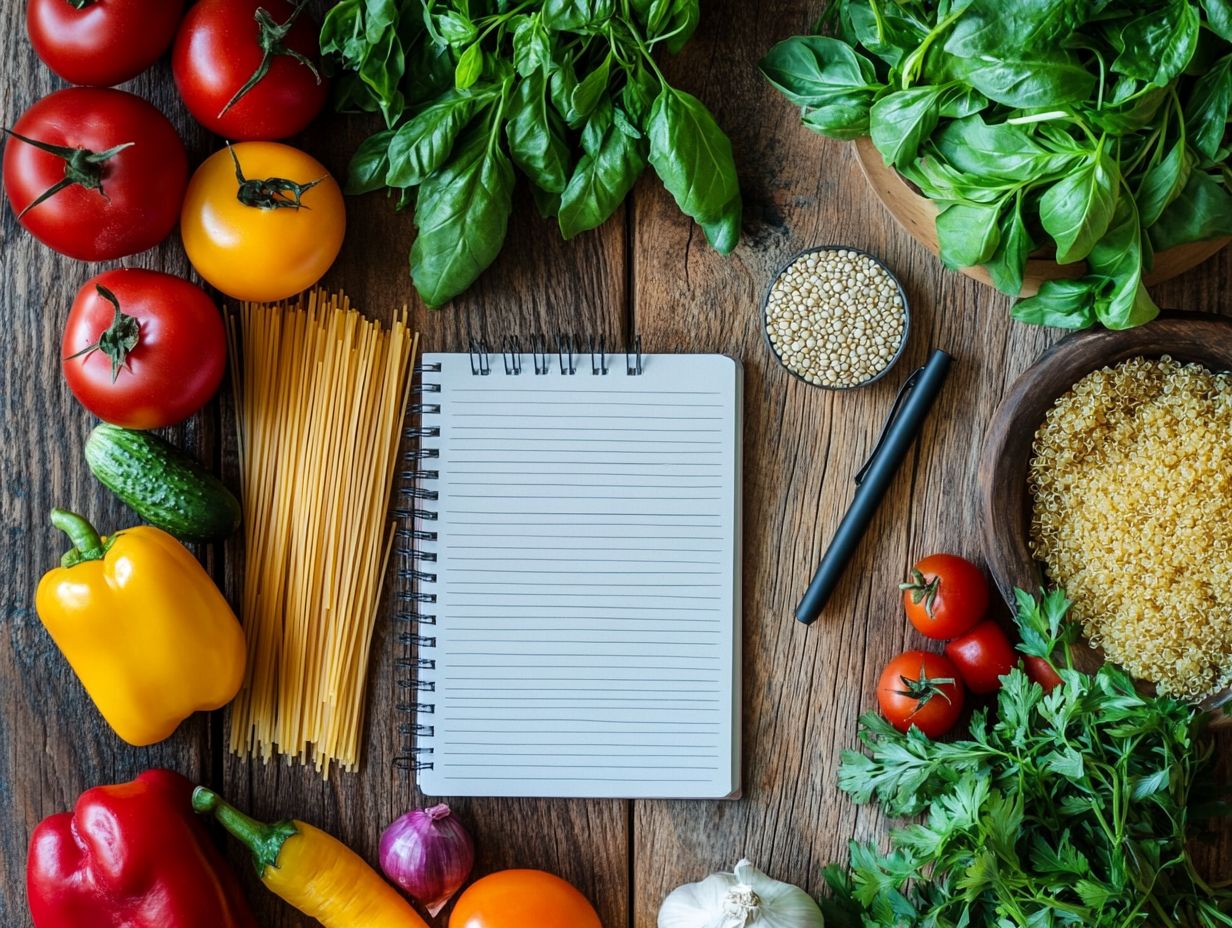
When you are transitioning to a gluten-free diet, it is crucial to identify the best substitutes for commonly used ingredients to preserve both flavor and nutrition in your meals. For instance, almond flour can effortlessly replace wheat flour. Additionally, gluten-free pasta made from rice or corn allows you to continue enjoying your favorite dishes without compromise.
Don t overlook the potential of vegetables like zucchini noodles or spaghetti squash. They can add delightful variety to your meals while keeping things gluten-free, ensuring that healthy eating is both satisfying and enjoyable.
Besides these substitutions, be mindful of gluten-containing ingredients such as barley, rye, and traditional soy sauce. These can easily be swapped out for quinoa, other gluten-free grains, or tamari. For bread, gluten-free wraps made from rice or chickpeas are fantastic options. For thickening soups or sauces, arrowroot powder or cornstarch shine as excellent alternatives.
Consider meal prep ideas that embrace creativity and health, like whipping up a vibrant quinoa salad packed with colorful vegetables and proteins or crafting a gluten-free stir-fry using fresh ingredients. Start experimenting with these ideas today and enjoy your gluten-free journey!
Eating Out on a Gluten-Free Diet
Dining out while adhering to a gluten-free diet may seem daunting, yet with the right strategies at your disposal, it can turn into an exciting adventure! Effectively communicating your dietary needs to restaurant staff and identifying gluten-free options on menus can greatly enhance the safety of your dining adventures.
Well-known dietitian Emily Lachtrupp highlights the necessity of researching restaurants in advance and inquiring about food preparation methods. This diligence helps prevent cross-contamination, which occurs when gluten-free foods touch gluten-containing foods, and allows you to maintain your commitment to a gluten-free lifestyle with confidence.
Tips for Dining at Restaurants
When dining out, you must employ specific strategies to navigate the menu choices effectively while adhering to a gluten-free diet. Clearly communicate your dietary restrictions to the waitstaff, ask for modifications, and inquire about preparation methods to enhance the likelihood of enjoying a safe gluten-free meal.
Emily Lachtrupp suggests bringing gluten-free snacks or meal options as a backup to elevate your dining experience and eliminate any uncertainty regarding available choices.
Planning ahead is equally essential. Before you head out, take the time to research the restaurant’s menu online. This equips you with a solid understanding of potential gluten-free options, allowing you to approach the waitstaff with informed questions.
When ordering, being specific about which foods contain gluten is beneficial, as some items may not be immediately apparent. A friendly demeanor can foster better communication, encouraging the staff to take your dietary needs seriously. Don t hesitate to discuss your requirements with the manager if necessary to ensure your meal is prepared safely.
Frequently Asked Questions
What is a gluten-free diet?
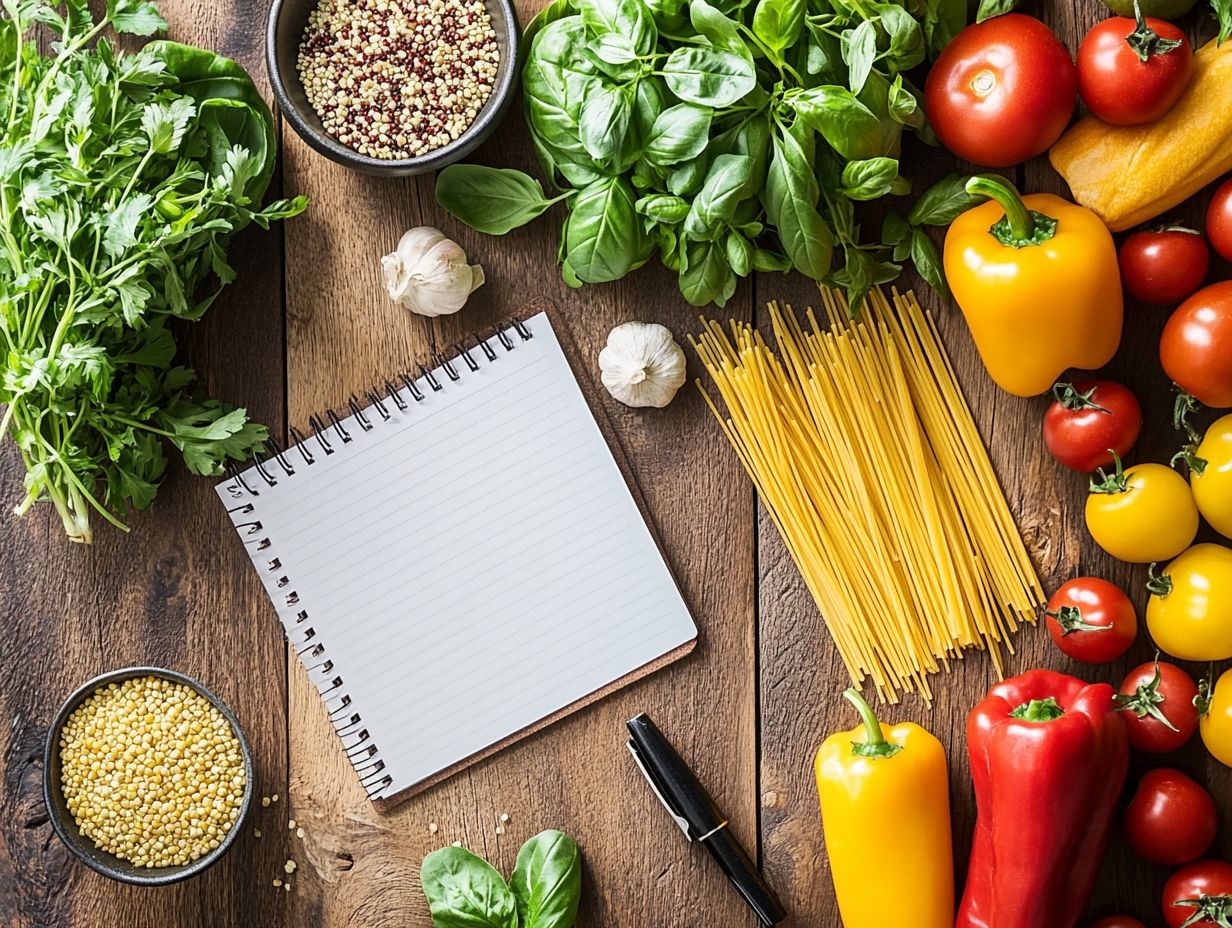
A gluten-free diet is a diet that excludes any foods containing gluten, a protein found in wheat, barley, and rye. This diet is essential for people with celiac disease or gluten intolerance.
How do I plan meals for a gluten-free diet?
Start by creating a list of gluten-free foods, such as fruits, vegetables, meats, fish, dairy, and gluten-free grains like quinoa and rice. Then, plan your meals around these ingredients. You can also try using gluten-free substitutes for your favorite dishes.
What are some gluten-free meal ideas?
- Grilled chicken with quinoa and roasted vegetables
- Gluten-free pasta with tomato sauce and meatballs
- A quinoa and black bean salad
You can also find many gluten-free recipes online.
Is meal planning necessary for a gluten-free diet?
Yes, meal planning is vital for a gluten-free diet. It ensures variety in your meals and helps you avoid gluten accidentally.
Meal planning can also save you time and money in the long run. With a solid plan, you’ll feel more confident about your food choices!
Can I eat out on a gluten-free diet?
You can definitely enjoy dining out while sticking to a gluten-free diet. Just let the restaurant staff know about your food choices and ask for gluten-free options.
Researching restaurants ahead of time can help, too. Look for those that specifically cater to gluten-free diets to make dining out easier!
Yes, gluten can hide in unexpected places like sauces, dressings, and seasonings. Always read labels carefully to catch any gluten sneaking in.
Being aware of cross-contamination in kitchens is also crucial. Educate yourself on common gluten sources to avoid hidden ingredients!

